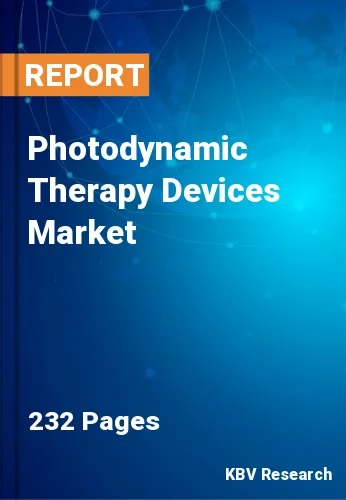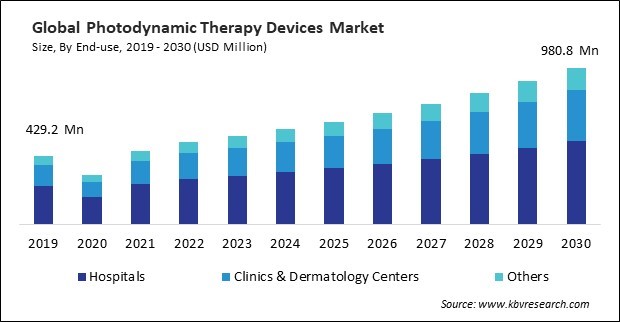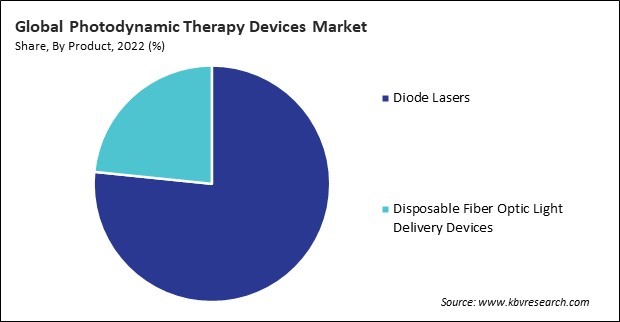
The Global Photodynamic Therapy Devices Market size is expected to reach $980.8 million by 2030, rising at a market growth of 8.5% CAGR during the forecast period.
PDT offers a unique advantage by selectively targeting cancer cells while sparing healthy tissues. Thus, the Cancer segment acquired $233.5 million in 2022. This targeted approach minimizes collateral damage, reduces side effects, and enhances the safety profile of the treatment. This characteristic is particularly attractive in the context of cancer management. PDT's adaptability allows it to treat both superficial and deep-seated tumors. This versatility is advantageous in addressing cancers at different stages and anatomical locations, providing a broader spectrum of applicability. Therefore, global cancer incidence is a significant driver for expanding the market.

Advancements in light sources, such as light-emitting diodes (LEDs) and lasers, contribute to more precise and efficient PDT treatments. Enhanced light delivery systems help optimize the activation of photosensitizers, allowing for better targeting of diseased cells while minimizing damage to healthy tissues. Ongoing R&D efforts focus on creating novel photosensitizers with improved selectivity, enhanced photodynamic activity, and reduced side effects. These next-generation photosensitizers contribute to the efficacy of PDT and expand its applicability across various medical specialties. Advances in optical fibers and light delivery systems contribute to improved light penetration and distribution during PDT. These enhancements enable effective treatment of deeper-seated lesions, expanding the range of applications across different medical specialties. Additionally, Combination therapies leverage the strengths of different treatment modalities to achieve synergistic effects. By combining photodynamic therapy with other interventions, such as chemotherapy or immunotherapy, healthcare providers seek to improve the overall efficacy of the treatment, leading to improved patient outcomes. PDT, when combined with other therapies, can influence the tumor microenvironment in ways that enhance the effectiveness of the overall treatment. Synergistic effects may include improved oxygenation, enhanced immune response, and modulation of signaling pathways critical for cancer cell survival. Factors such as the type and stage of cancer, genetic profile, and patient response to previous treatments can be considered in tailoring combination approaches with PDT. Thus, exploring combination therapies and synergistic approaches expands the market.
Further, during the initial phases of the pandemic, the healthcare sector saw a significant disruption in routine medical procedures and elective treatments. This disruption affected the demand for PDT devices, particularly in dermatology and elective oncology applications. The global supply chain disruptions and manufacturing challenges brought about by the pandemic impacted the availability of medical devices, including PDT devices. Delays in production, distribution, and procurement of essential components had temporarily hindered market growth. The market saw increased interest in PDT devices for applications related to microbial decontamination in healthcare settings. Therefore, the COVID-19 pandemic had a moderate impact on the market.
However, the initial investment required for acquiring PDT devices and related equipment can be substantial. For healthcare providers, especially in resource-constrained settings, the high entry cost may limit PDT adoption. This affects the economic feasibility of integrating PDT into clinical practice. PDT treatments involve the use of photosensitizing agents, which can be expensive. The cost of consumables, including photosensitizers, adds to the overall expense of PDT. Limited reimbursement and high consumable costs can negatively impact the economic viability of offering PDT treatments. Patients in certain regions or socioeconomic groups may face barriers in accessing PDT, leading to disparities in healthcare outcomes. As a result, the above aspects will cause the market growth to decline.
 Drivers
Drivers  Restraints
Restraints  Opportunities
Opportunities  Challenges
Challenges By end-use, the market is classified into hospitals, clinics & dermatology centers, and others. In 2022, the hospitals segment registered the highest revenue share in the market. Several factors contribute to its significance and influence on the market dynamics. These driving factors include the increasing adoption of photodynamic therapy in hospital settings for the treatment of various medical conditions, the growing prevalence of cancer and dermatological disorders prompting the demand for effective and non-invasive treatment options, and advancements in photodynamic therapy technologies that make it a preferred choice in hospital-based interventions. In addition, the hospital segment is characterized by a high level of expertise and infrastructure, enabling the efficient implementation of photodynamic therapy procedures.
On the basis of product, the market is segmented into diode lasers and disposable fiber optic light delivery devices. The disposable fiber optic light delivery devices segment acquired a substantial revenue share in the market in 2022. The disposability of fiber optic light delivery devices provides benefits such as improved hygiene, lowered cross-contamination risks, and cost-effectiveness. The healthcare industry progressively acknowledges the practicality and effectiveness of disposable devices, fostering this market growth. Moreover, the disposable fiber optic light delivery devices sector is experiencing expansion driven by advancements in fiber optic technology and a growing demand for minimally invasive procedures. These devices address the changing requirements of healthcare professionals, delivering heightened precision in light delivery and optimizing treatment outcomes.

Based on application, the market is fragmented into cancer, actinic keratosis, acne, psoriasis, and others. In 2022, the cancer segment held the highest revenue share in the market. PDT relies on photosensitizing agents that generate reactive oxygen species when activated by light. These reactive oxygen species induce cell damage and apoptosis (programmed cell death) in the targeted cancer cells. Various photosensitizing agents are under investigation, and their properties contribute to the specificity and efficacy of PDT in cancer treatment. Researchers and clinicians are exploring the integration of PDT with other cancer treatment modalities. Combination therapies aim to enhance the overall effectiveness of cancer treatment by addressing different aspects of the disease.
Free Valuable Insights: Global Photodynamic Therapy Devices Market size to reach USD 980.8 Million by 2030
Region-wise, the market is analysed across North America, Europe, Asia Pacific, and LAMEA. In 2022, the North America region witnessed the largest revenue share in the market. This can be attributed to several aspects, including increased healthcare expenditure, the presence of certified professionals, well-established healthcare infrastructure, a concentration of key market players in the U.S., a growing demand for innovative biologics in cancer treatment, widespread adoption of photodynamic therapy, and continuous product launches by industry stakeholders. Strategic initiatives, specifically geared towards targeted cancer control and investments in advanced early detection and treatment methodologies, play a pivotal role in reducing cancer mortality rates. The rising incidence of cancer in the U.S. is expected to drive demand for treatment, thereby fueling the market expansion in the region.
| Report Attribute | Details |
|---|---|
| Market size value in 2022 | USD 517.5 Million |
| Market size forecast in 2030 | USD 980.8 Million |
| Base Year | 2022 |
| Historical Period | 2019 to 2021 |
| Forecast Period | 2023 to 2030 |
| Revenue Growth Rate | CAGR of 8.5% from 2023 to 2030 |
| Number of Pages | 232 |
| Number of Tables | 360 |
| Report coverage | Market Trends, Revenue Estimation and Forecast, Segmentation Analysis, Regional and Country Breakdown, Porter’s 5 Forces Analysis, Company Profiling, Companies Strategic Developments, SWOT Analysis, Winning Imperatives |
| Segments covered | Product, Application, End-use, Region |
| Country scope |
|
| Companies Included | Boston Scientific Corporation, Biolitec AG, Coherent Corp., Iridex Corporation, Candela Corporation (Syneron Medical), Cutera, Inc., Lumenis Be Ltd., Lumibird Medical Nordics Ab (LUMIBIRD), Excel Lasers Limited, Modulight corporation |
By End-use
By Product
By Application
By Geography
The Market size is projected to reach USD 980.8 million by 2030.
Ongoing advancements in technology are driving the Market in coming years, however, High cost of equipment and treatment restraints the growth of the Market.
Boston Scientific Corporation, Biolitec AG, Coherent Corp., Iridex Corporation, Candela Corporation (Syneron Medical), Cutera, Inc., Lumenis Be Ltd., Lumibird Medical Nordics Ab (LUMIBIRD), Excel Lasers Limited, Modulight corporation
The expected CAGR of this Market is 8.5% from 2023 to 2030.
The Diode Lasers segment is leading the Market, By Product in 2022; there by, achieving a market value of $712.2 million by 2030.
The North America region dominated the Market, By Region in 2022, and would continue to be a dominant market till 2030; there by, achieving a market value of $379.4 million by 2030.
Our team of dedicated experts can provide you with attractive expansion opportunities for your business.
